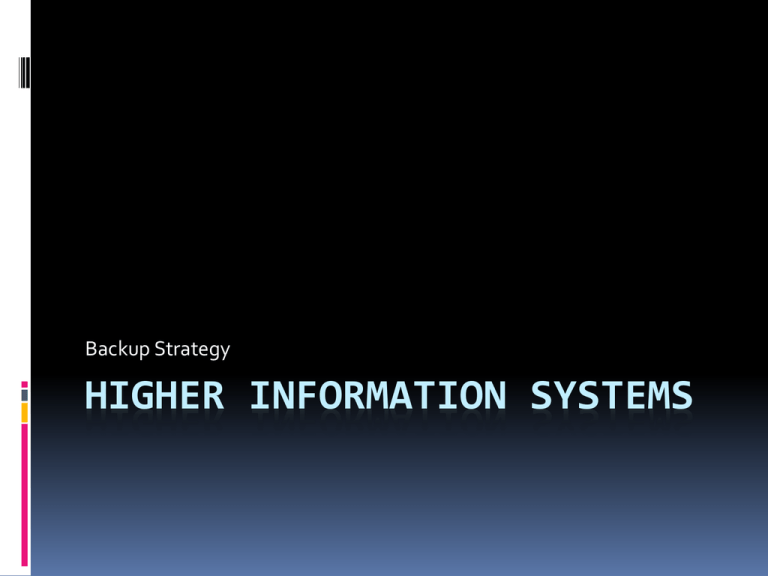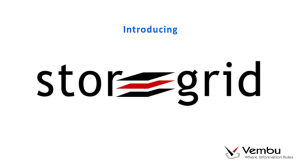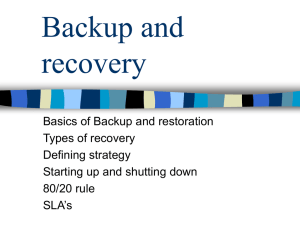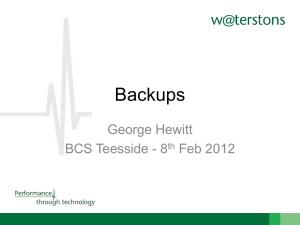Backup Strategy
advertisement

Backup Strategy HIGHER INFORMATION SYSTEMS Backup Strategy An Exam question will ask you to describe a backup strategy. Be able to explain: Safe, secure place in different location. Why? – For disaster recovery. Talk about rotation method – we will look at Grandfather, Father, Son. Need to know – Archive, Recovery Storage methods Frequency & Version Control Rotation Method (Grandfather Father, Son) Backup Strategy Data can often be irreplaceable so a copy must be created that is stored in a safe secure location away from the original. The media used for this will be: •Tape (magnetic) •External portable hard disks (plural, not just one disk) The reason for a backup is to ensure that the most recent copy of the data can be recovered and restored. Backup Strategy Causes: Physical Fire Flood Building collapse Electronic Corrupted hard disk Files being Accidentally erased Virus attack on a disk Backup Strategy Archive Files that are not accessed often can be saved to tape for long term storage. If required they can be accessed at a later date. This frees up hard disk space. They are a permanent copy - not to be used for recovery (it is the backup that is used if there is a disaster). Backup Strategy Recovery The most important thing to do once data has been backed up is to ensure this has been successful. When the data needs to be accessed it is brought from the off-site location and the recovery software will restore the data. When you need to recover data that has been corrupted (or accidently deleted) you would use the most recent (full) backup as well as all the subsequent incremental backups. Backup Strategy Full backup •Taken at a fixed time, e.g. once per day/per week. This backs up everything including the data and the software programs. •Thereafter incremental backups (daily, weekly), this means only files that have been amended since the last full or incremental backup are backed up. •Recovery software deals with this – it can be set to full/incremental. Backup Strategy Storage Methods: Media: •Magnetic tapes – DAT tapes •Multiple hard drives using USB connections. •Stored in a fire-proof safe •Stored off site away from the original Backup Strategy Frequency and Version Control Frequency: A backup has to be completed by the start of business the next morning. A full backup is done on a Friday or Saturday night. This is done automatically so the operator does not have to be present. Incremental backups are done each evening. (A backup should be done at least once per day). Backup Strategy Frequency and Version Control Version: This is the full backup plus incremental tapes made up throughout the week. They must be labelled clearly and kept together. A set of these tapes in the G,F,S rotation method is known as a generation. E.g. If the system was corrupted on Wednesday to fully restore the data you would need the full backup (done on Friday night) plus the incremental tapes. It depends on how this is done but you must end up with all the data restored to the system. Backup Strategy Grandfather, Father, Son The cost or time required to do a full backup everyday can be impractical. Many users therefore will do either an incremental or differential backup most days. (An incremental backup is a backup of every file on a file system which has changed since the last backup.) Differential Backs up every file that has changed since the last full backup is backed up each time. It is faster to restore a differential backup. All you need is the last full and last differential backup. http://www.techfaq.com/incremental -backup.shtml Backup Strategy Grandfather, Father, Son Incremental Backups back only the files that have changed since the last full or incremental backup are backed up. Subsequent incremental backups only back up those files that have changed since the previous incremental backup. It takes longer to restore data since data from the last full backup, plus data from all the incremental backups, must be restored. Grandfather-Father-Son The most commonly used media rotation schedule is "Grandfather-Father-Son" (GFS). This scheme uses daily (Son), weekly (Father), and monthly (Grandfather) backup sets. Son – each day of the week Father - at the end of each week Grandfather - last day of the month Annual Grandfather-Father-Son. Under this scheme the “Son” group of media consists of four backup media are labelled for the day of the week each backs up; for example, Monday to Thursday. The “Father” group of media consists of a set of four weekly backup media is labelled "Week1," "Week2," and so on. The "Grandfather" media consists of a set of full backups on the last business day of each month of the year and an archive copy which is removed offsite. Backup Strategy We have learned: Safe, secure place in different location. Why? – For disaster recovery. Causes - Physical or Electronic Archive Recovery Storage methods Frequency & Version Control Rotation method –Grandfather, Father, Son. Question 2008 Q17 Lachlan is preparing for an interview for the job of network security manager at First Place Ltd. The company has 4 warehouses supplying 40 branches throughout the country. As stock control system is used to manage daily supplies to each branch. As part of the interview he will be asked about a security strategy for the company’s organisational information system. (b) Describe a suitable backup strategy for First Place Ltd. Your answer should describe: • A storage method • A recovery method • A rotation method (5)






